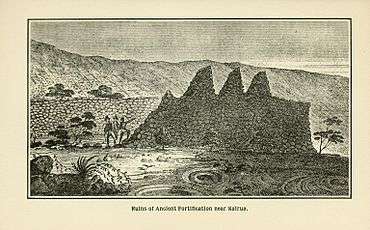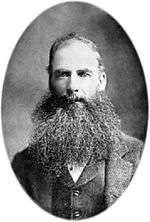William Ellis (missionary)
| William Ellis | |
|---|---|
|
From the London Missionary Society | |
| Born |
29 August 1794 London, England |
| Died |
9 June 1872 (aged 77) Hoddesdon, Hertfordshire, England |
| Spouse(s) |
Mary Mercy Moor Sarah Stickney |
| Signature | |
|
| |
William Ellis (29 August 1794 – 9 June 1872) was an English missionary and author. He traveled through the Society Islands, Hawaiian Islands and Madagascar, and wrote several books describing his experiences.
Early life
He was born in London of working class parents on 24 August 1794.[1] His father and a short-lived older brother were also named William. Not much is known of his mother, except the maiden name of Bedborough, birthplace of Reading, England and wedding date of 13 August 1792.[2] He developed a love of plants in his youth and became a gardener, first in the East of England, then at a nursery north of London and eventually for a wealthy family in Stoke Newington. Being of a religious nature, he applied to train as Christian missionary for the London Missionary Society and was accepted to the school.
Mission to Polynesia
After attending Homerton College, then in Hampstead, he was ordained in 1815, and married Mary Mercy Moor on 9 November 1815.[1] He was posted to the South Sea Islands with his wife, leaving England on 23 January 1816. They arrived at Eimeo, one of the Windward Islands, via Sydney and learned the language there. During their stay there several chiefs of nearby Pacific islands who had assisted Pomare in regaining sovereignty of Tahiti, visited Eimeo and welcomed the LMS missionaries (including John Orsmond and John Williams and their wives) to their own islands. All three missionary families went to Huahine, arriving in June 1818, drawing crowds from neighbouring islands, including King Tamatoa of Raiatea.

Ellis and a small group travelled from Tahiti on the schooner Mermaid to the Hawaiian Islands, known then as the "Sandwich Islands". On the same voyage, another small schooner called Prince Regent with six cannons was presented to King Kamehameha II. They arrived in Honolulu on 16 April 1822, and although the plan had been to visit the Marquesas Islands, they returned to Tahiti on 27 August 1822. He was invited to stay, and brought his family to Hawaii, arriving on the Active on 4 February 1823.[1] In June 1823 Ellis joined American Missionaries Asa Thurston, Artemas Bishop and Joseph Goodrich on a tour of the island of Hawaiʻi, to investigate suitable sites for mission stations. On the way he stopped at Maui and met Queen Keōpūolani. Their first stop was Kailua-Kona, where they met the Governor of the island Kuakini, known as "John Adams".
They visited Kealakekua Bay, and toured the historic sites nearby, such as the Puʻuhonoua o Hōnaunau. They traveled south past the Mauna Loa volcano. They were some of the first Europeans to visit the caldera of the Kīlauea volcano, which was active at the time. On the eastern side they visited Hilo and Waipiʻo Valley, and some of the party continued up snow-covered Mauna Kea. Some of the important missions set up as a result of this trip include Mokuaikaua Church, Imiola Church, Kealakekua Church, and the Haili Church. Returning to Honolulu, he learned the Hawaiian language, transcribed the language into a roman alphabet and helped set up a printing press.
In England

In August 1824 he had to return to England since Mrs. Ellis was in poor health, so took a ship via America. Back in London, he published his narrative of travels in Hawaii. Ellis became Assistant Foreign Secretary of the London Missionary Society (1830), and then Chief Foreign Secretary. Mary Ellis died on 11 January 1835, after having four children.[1] He published a biography of Mary Mercy Ellis in 1836.
Ellis remarried two years later, to Sarah Stickney (1799–1872). She had been brought up a Quaker but had latterly chosen to become an Independent or Congregationalist, as were many of those involved in the London Missionary Society albeit non-denominational. She also shared her husband's love of books and of writing. Ellis had started to become a successful topographical, historical, botanical and ethnographic author about Polynesia since returning from the South Seas and the new Mrs Ellis was a highly successful author, primarily of books on women's role in society.
Ellis' most important contribution was Polynesian Researches. This firmly established him as a talented enthographic and geographical writer. The book was reviewed in the Quarterly Review by Robert Southey with the flattering words: "A more interesting book we have never perused". This, and similar acclaim for the writing of Ellis from others, is said to have done much to change hostile attitudes from investors towards Missionaries, particularly the LMS missionaries;who were often portrayed as naively raising the expectations, educational level, liberty and status of slaves and native peoples, rather than taking a traditionally hard-headed approach to trade and commerce.
Ellis was asked by the directors of the LMS to write up his studies of Madagascar. It appeared in 1838 as a two volume History of Madagascar. In 1844 the first volume of a History of the London Missionary Society was also published. He resigned from the LMS due to ill health and to spend more time with his wife in their house in the countryside village of Hoddesdon in Hertfordshire, twenty miles north of London. Three years later, in 1847 he was offered a post there as pastor of its Congregationalist worshipers.
Mission to Madagascar

After five years, Ellis recovered his health and he accepted an offer from the LMS to travel to Madagascar for them as their official emissary. Arriving in 1853, his mission was rebuffed and he was refused permission to go to the capital. Basing himself in Mauritius for a while, he tried again and was again refused entry. A third visit was made in 1856 although the Queen allowed him only a one-month stay. In celebration he wrote a book entitled Three Visits to Madagascar, 1858.
On his fourth attempt, in 1861 he was eventually permitted entry. There were said to be issues underlying the delay relating to French influence in the area. Ellis stayed until 1865, and gradually laid the foundations for Christianity. He returned to a great welcome in England in 1865 and was asked to lecture widely about his travels and the religious influence he had left behind. Four years later, in 1869, Queen Ranavalona II and the royal court converted to Christianity.
Ellis wrote books about his experiences and the history and geography of the island – Madagascar Revisited, 1867, and Martyr Church of Madagascar, 1870.
Death

In 1872 he caught a cold while on a train journey and died on 9 June 1872. Mrs Sarah Ellis died seven days later on 16 June. After thirty-five years of marriage, they died within a week of each other.
Ellis is buried in a venerated spot in the Congregationalists' non-denominational Abney Park Cemetery in London where Isaac Watts once lived. His intricately carved hip tomb is perfectly aligned with its chapel. His independently minded wife preferred to be buried near their country home. A biography written by his son John and Henry Allon was published soon after his death.[2]
Works
- William Ellis (1823). "A journal of a tour around Hawai'i, the largest of the Sandwich Islands". Crocker and Brewster, New York, republished 2004, Mutual Publishing, Honolulu. ISBN 1-56647-605-4.
- William Ellis (1829). Polynesian researches, during a residence of nearly six years in the South Sea Islands, Volume 1. Fisher, Son & Jackson.
- William Ellis (1829). Polynesian researches, during a residence of nearly six years in the South Sea Islands, Volume 2. Fisher, Son & Jackson.
- William Ellis (1832). Polynesian researches during a residence of nearly eight years in the Society and Sandwich Islands Volume 3 (Second ed.). Fisher, Son & Jackson.
- William Ellis (1836). Memoir of Mrs. Mary Mercy Ellis (American ed.). Crocker & Brewster.
- William Ellis (1859). Three visits to Madagascar during the years 1853-1854-1856. Harper.
- William Ellis (1867). Madagascar revisited, describing the events of a new reign and the revolution which followed. John Murray. ISBN 0-548-22734-9.
- William Ellis (1870). The martyr church: a narrative of the introduction, progress, and triumph of Christianity in Madagascar. J. Snow. ISBN 0-8370-0407-1.
Notes
- 1 2 3 4 Hawaiian Mission Children's Society (1901). Portraits of American Protestant missionaries to Hawaii. Honolulu: Hawaiian gazette co. p. 10.
- 1 2 John Eimeo Ellis and Henry Allon (1873). Life of William Ellis, missionary to the South Seas and to Madagascar.
References
This article incorporates text from a publication now in the public domain: Wood, James, ed. (1907). "article name needed". The Nuttall Encyclopædia. London and New York: Frederick Warne.
External links
-
 Media related to William Ellis (missionary) at Wikimedia Commons
Media related to William Ellis (missionary) at Wikimedia Commons -
 Works related to William Ellis at Wikisource
Works related to William Ellis at Wikisource -
 Works related to Journal of William Ellis (1825) at Wikisource
Works related to Journal of William Ellis (1825) at Wikisource
